Supplemental Bodyweight Training

As the owner of Horsepower Strength and Conditioning and creator of the Powerology training system, I work with athletes of all levels, ranging from complete beginners to professional athletes competing at the highest levels. No matter which client I am working with, my programs are focused on barbell training, jumping, sprinting and bodyweight training.
The foundation for strength and power training begins and ends with a barbell. The programs that I use are built around Olympic lifting, explosive barbell variations, squats, deads, and barbell lunges. With this programming, my athletes do a large amount of vertical pushing and pulling. Ninety percent of what we do is spent with the barbell over our area of balance (heel bone to balls of feet). This leaves a void that needs to be filled to make sure our athletes are well-rounded, working through a full range of motion, and keeping everything strong and flexible to maximize performance while making them less injury prone. I supplement in horizontal bodyweight pushing and pulling exercises at the end of every workout. I break our workouts down into push days and pull days.
A typical push day would include the following exercises:
• Split Jerk
• Push Press
• Seated Box Jump
• Barbell Lunges
• Sprint Variation
• Bodyweight Push
A typical pull day would look like this:
• Cleans
• High Pull
• Box Jumps
• Squats
• Change of Direction
• Bodyweight Pull
Exercise Selection:
When I select each bodyweight exercise, I look to see if they meet the following criteria.
1. Does the exercise build strength?
2. Does it build speed?
3. Does it improve muscular endurance?
4. Are progressions measureable?
All of the exercises that I use in my programming hit at least one, if not more of the above criteria. In addition, I pick exercises to round out the workout with pushing and pulling from different angles than my athletes are getting from the barbell programming.
These are the exercise that I use for the bodyweight pushing and pulling. The sets and reps can be determined by each individual athlete’s strength program.
Horizontal Pushes
Burn out Chain Pushups (4,3,2,1,BW) (suggestion 1- 4 sets)
• Start with four chains around the athletes neck hang freely to the ground (use chains weight appropriate with athletes strength level
• Do as many reps as possible with 4 chains, remove 1 chain
• Do as many reps as possible with 3 chains, remove 1 chain
• Do as many reps as possible with 2 chains, remove 1 chain
• Do as many reps as possible with 1 chain, remove chain
• Do as many Body weight reps as possible
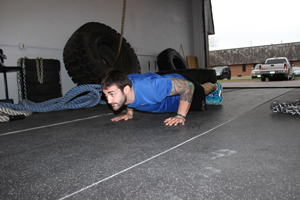
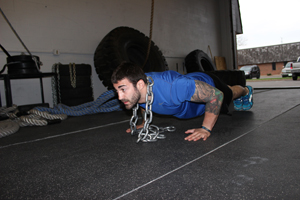
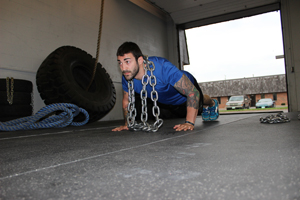


Plyo Push Ups (Suggestion 5 sets of 5)
• Chest on floor, body laying flat on ground
• Hands off the floor
• Drive your hands down and push your body off the ground (Jump with your arms)
• Toes should stay on the ground the entire time (ultimate goal, push yourself to a standing position while keeping your back flat.
• Catch yourself with your arms, lower body back to start position
Push Up Plank Sequence (Suggestion 5 Reps, 1-5 Sets)
• 5 Plyo Pushups, Plank walk 10 yards down, 10 Yard Back, Burn out Pushups
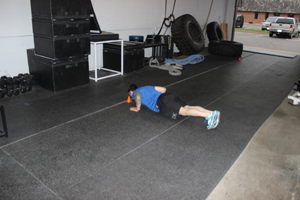
Horizontal Pulls
Rope Climbs (suggestion 5-10 Reps, 3-5 Sets)
• Start Laying flat on your back
• Keep back straight
• Heels on the ground
• Climb Rope hand over hand until in a standing position
• Once this becomes easy, the athlete can progress to rope climbs only using the upper body.
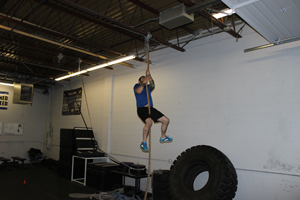
Single arm rope pulls (suggestion 5 reps, 3-5 sets)
• Start laying flat on your back
• Reach up as high as you can with one arm
• Explosive pull yourself to a standing position with one arm
Reverse Rows (suggestion 5-10 reps, 3-5 sets)
• Set a Barbell up at a height so the athletes back does not touch the ground when hanging
• Overhand or Underhand grip can be used
• Hands slightly wider that shoulder width
• Set a box for the athlete to put their feet on
• Explosively pull Chest to bar
Single Arm Reverse Rows (suggestion 5-10 reps, 3-5 sets)
• Every is the same as above, except we are doing the exercise with one hand
• Center your pulling hand on the bar
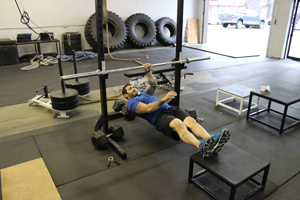
As I work through a training cycle with an athlete, strength improvements (increased reps), speed improvements, and height improvements are how I assess the gains with bodyweight movements. I progress athletes programming, moving to more difficult exercises as the athlete becomes stronger. I will add volume throughout the training cycle as the athlete’s work
capacity increases.
Example Push Day Programming:
Push Day
Week 1
• 3xBO – 4chains/3chains/2chains/1chain/BW
Week 2
• 5x5 – Plyo Push Ups
Week 3
• 5x Push Up Plank Sequence
Week 4
• 3xBO – 2chains
• 3x5 – Plyo Push Ups
Week 5
• 3xBO – 4chains/3chains/2chains/1chain/BW
Week 6
• 5x5 – Plyo Push Ups
Week 7
• 5x Push Up Plank Sequence
Week 8
• 2xBO – 2chains
• 3x5 – Plyo Push Ups
Example Pull Day Programming
Pull Day
Week 1
• 5x5 Reverse Rows
Week 2
• 5x5 Rope Climbs (Ground to Standing)
Week 3
• 5x5 (each hand) Single Arm Reverse Rows
Week 4
• 5x5 (each hand) Single Arm Rope Climbs
Week 5
• 3x5 Reverse Rows
• 3x5 (each Hand) Single Arm Reverse Rows
Week 6
• 3x5 Rope Climbs
• 3x5 (each hand) Single Arm Rope Climbs
Week 7
• 5x 25’ Rope Climbs
Week 8
• 5x25’ Rope Climbs
• 3x5 Reverse Rows
Horizontal bodyweight pushing and pulling has been a great addition to the barbell programming that I do at Horsepower. This addition has helped to make sure that our athletes are working their strength at all angles, and builds the assistance muscles to keep progressing with their barbell training, which allows them to become stronger, better prepared athletes.
The foundation for strength and power training begins and ends with a barbell. The programs that I use are built around Olympic lifting, explosive barbell variations, squats, deads, and barbell lunges. With this programming, my athletes do a large amount of vertical pushing and pulling. Ninety percent of what we do is spent with the barbell over our area of balance (heel bone to balls of feet). This leaves a void that needs to be filled to make sure our athletes are well-rounded, working through a full range of motion, and keeping everything strong and flexible to maximize performance while making them less injury prone. I supplement in horizontal bodyweight pushing and pulling exercises at the end of every workout. I break our workouts down into push days and pull days.
A typical push day would include the following exercises:
• Split Jerk
• Push Press
• Seated Box Jump
• Barbell Lunges
• Sprint Variation
• Bodyweight Push
A typical pull day would look like this:
• Cleans
• High Pull
• Box Jumps
• Squats
• Change of Direction
• Bodyweight Pull
Exercise Selection:
When I select each bodyweight exercise, I look to see if they meet the following criteria.
1. Does the exercise build strength?
2. Does it build speed?
3. Does it improve muscular endurance?
4. Are progressions measureable?
All of the exercises that I use in my programming hit at least one, if not more of the above criteria. In addition, I pick exercises to round out the workout with pushing and pulling from different angles than my athletes are getting from the barbell programming.
These are the exercise that I use for the bodyweight pushing and pulling. The sets and reps can be determined by each individual athlete’s strength program.
Horizontal Pushes
Burn out Chain Pushups (4,3,2,1,BW) (suggestion 1- 4 sets)
• Start with four chains around the athletes neck hang freely to the ground (use chains weight appropriate with athletes strength level
• Do as many reps as possible with 4 chains, remove 1 chain
• Do as many reps as possible with 3 chains, remove 1 chain
• Do as many reps as possible with 2 chains, remove 1 chain
• Do as many reps as possible with 1 chain, remove chain
• Do as many Body weight reps as possible





Plyo Push Ups (Suggestion 5 sets of 5)
• Chest on floor, body laying flat on ground
• Hands off the floor
• Drive your hands down and push your body off the ground (Jump with your arms)
• Toes should stay on the ground the entire time (ultimate goal, push yourself to a standing position while keeping your back flat.
• Catch yourself with your arms, lower body back to start position
Push Up Plank Sequence (Suggestion 5 Reps, 1-5 Sets)
• 5 Plyo Pushups, Plank walk 10 yards down, 10 Yard Back, Burn out Pushups

Horizontal Pulls
Rope Climbs (suggestion 5-10 Reps, 3-5 Sets)
• Start Laying flat on your back
• Keep back straight
• Heels on the ground
• Climb Rope hand over hand until in a standing position
• Once this becomes easy, the athlete can progress to rope climbs only using the upper body.

Single arm rope pulls (suggestion 5 reps, 3-5 sets)
• Start laying flat on your back
• Reach up as high as you can with one arm
• Explosive pull yourself to a standing position with one arm
Reverse Rows (suggestion 5-10 reps, 3-5 sets)
• Set a Barbell up at a height so the athletes back does not touch the ground when hanging
• Overhand or Underhand grip can be used
• Hands slightly wider that shoulder width
• Set a box for the athlete to put their feet on
• Explosively pull Chest to bar
Single Arm Reverse Rows (suggestion 5-10 reps, 3-5 sets)
• Every is the same as above, except we are doing the exercise with one hand
• Center your pulling hand on the bar

As I work through a training cycle with an athlete, strength improvements (increased reps), speed improvements, and height improvements are how I assess the gains with bodyweight movements. I progress athletes programming, moving to more difficult exercises as the athlete becomes stronger. I will add volume throughout the training cycle as the athlete’s work
capacity increases.
Example Push Day Programming:
Push Day
Week 1
• 3xBO – 4chains/3chains/2chains/1chain/BW
Week 2
• 5x5 – Plyo Push Ups
Week 3
• 5x Push Up Plank Sequence
Week 4
• 3xBO – 2chains
• 3x5 – Plyo Push Ups
Week 5
• 3xBO – 4chains/3chains/2chains/1chain/BW
Week 6
• 5x5 – Plyo Push Ups
Week 7
• 5x Push Up Plank Sequence
Week 8
• 2xBO – 2chains
• 3x5 – Plyo Push Ups
Example Pull Day Programming
Pull Day
Week 1
• 5x5 Reverse Rows
Week 2
• 5x5 Rope Climbs (Ground to Standing)
Week 3
• 5x5 (each hand) Single Arm Reverse Rows
Week 4
• 5x5 (each hand) Single Arm Rope Climbs
Week 5
• 3x5 Reverse Rows
• 3x5 (each Hand) Single Arm Reverse Rows
Week 6
• 3x5 Rope Climbs
• 3x5 (each hand) Single Arm Rope Climbs
Week 7
• 5x 25’ Rope Climbs
Week 8
• 5x25’ Rope Climbs
• 3x5 Reverse Rows
Horizontal bodyweight pushing and pulling has been a great addition to the barbell programming that I do at Horsepower. This addition has helped to make sure that our athletes are working their strength at all angles, and builds the assistance muscles to keep progressing with their barbell training, which allows them to become stronger, better prepared athletes.
|
Matt Miller is the owner of Horsepower Strength & Conditioning, located in Minneapolis, Minn. He earned a bachelor’s degree in Physical Education (Bethel University) and a Master’s degree in Sports Management (University of Concordia, St. Paul). He is a Certified Strength and Conditioning Specialists (NSCA), a Certified MMA Condtioning Coach, and a Certified USA Weightlifting Sports Performance Coach. Matt serves as the head strength and conditioning coach for many fighters around the country and has experience in hundreds of fight camps including many fights for the UFC, Bellator and Invicta. |
Search Articles
Article Categories
Sort by Author
Sort by Issue & Date
Article Categories
Sort by Author
Sort by Issue & Date

